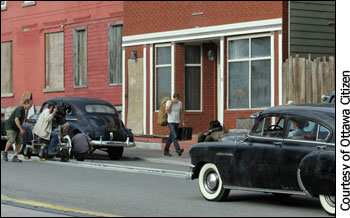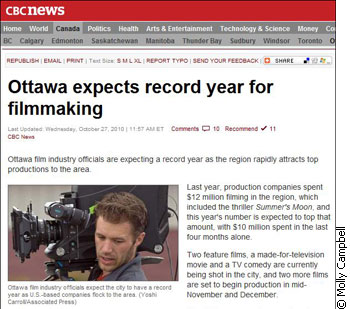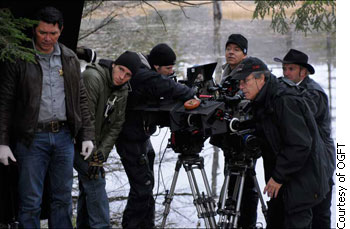Tags
Related Posts
Share This
‘Hollywood North…east’? Ottawa vies to be a moviemaking capital
Within the daytime serenity of Ottawa’s Shenkman Arts Centre, the phone never stops ringing in Roch Brunette’s small office.
With a one-person staff, Brunette is the general manager of the Ottawa Gatineau Film and Television Development Corporation (OGTF), a government-funded organization formed in 2003 to connect foreign film producers to the resources and locations they need to shoot in Ottawa.

Papineau Street in Gatineau lends a vintage look for the filming of Jack Kerouac’s On the Road, starring Garrett Hedlund (centre).
Brunette does a lot more than location scouting. He actively “sells” Ottawa to filmmakers, spending most of his time personally calling and emailing people in Los Angeles and New York City, then helping them scout locations once they agree to check out Ottawa. Since government dollars don’t go very far, Brunette can’t travel much and so does most of the legwork from his desk.
His stamina seems to be paying off, though. “What we’re seeing is a lot more direct calls from New York–based producers because they heard about Ottawa being a cool place to shoot,” he says.
Between 2008 and 2009, foreign location and service production decreased by 18.2 percent in Canada, according to a Canadian Media Production Association study. Brunette says 2009 was a bad year for Ottawa, too. But in September–November 2010 the city suddenly saw about 12 months’ worth of filmmaking, with $50 million in production volume of hitting the city in just three months.
Part of this new-found attention from American filmmakers is due to the good word on two big productions successfully shot in town this summer.

With two major U.S. productions here in summer 2010, headlines claimed Ottawa as the newest Canadian filmmaking hotspot.
In August, film crews made over Gatineau to look like 1940s Colorado to shoot the movie version of Jack Kerouac’s classic novel, On the Road, a $25 million film produced by Francis Ford Coppola and directed by Walter Salles, starring Twilight alumna Kristen Stewart. In the same month, L.A.-based producer Aaron Ryder shot his latest horror flick, The House at the End of the Street, in Ottawa, as a co-production with local company Zed Filmworks.
Both producers found what they were looking for—from locations to talented actors, extras and editing crews—in Ottawa: proof that the city just might have what it takes to be a filmmaking hotspot.
“He’s going to come back,” Brunette says of Ryder, whose film crew didn’t really know Ottawa existed before the summer. “The first question these producers ask when you mention Ottawa is, ‘What is Ottawa?’ But then they get here, they shoot their movies and they ask, ‘Where were you all this time? How come you weren’t on the map?’”
Located between two well-established film hubs, Toronto and Montreal, Ottawa is often off the map for foreign film producers simply because it’s too small, says Peter Finestone, commissioner of the Toronto Film and Television Office.
“Ottawa has a variety of looks on any given day, but Ottawa maxes out pretty quickly compared to Toronto,” he says. “There is much more infrastructure here [in Toronto]”.
‘We’re seeing a lot more calls from New York–based producers because they heard about Ottawa being a cool place to shoot.’ – Roch Brunette
Another obstacle for local production is the presence of federal government, says location scout Ainslie S. Wiggs.
“I find it very challenging to work here because people have a government mentality, and the art of filmmaking is just something that doesn’t necessarily fit into that box,” she says. Because of the three levels of government in Ottawa, she says there are more permits needed for shooting on streets, especially in the downtown core near Parliament Hill
However, Brunette says crews are starting to choose Ottawa over Toronto because rental space is cheaper, locations tend to be closer together and there’s less traffic here.
Furthermore, Ottawa has appeal for film producers because of its attractive outdoor spaces and old-fashioned architecture. According to Wiggs, 19th-century buildings like the Museum of Nature have been used for period pieces, and bigger homes in the small towns outside the city often play host to productions.
Another boost to runaway production has been increased tax incentives. In 2007 the Ontario government increased foreign-service tax credits by 38 percent, according to FilmOntario.
And finally as a cause there is enhanced government support. FilmOntario’s research efforts and work have led to an extra $200 million from the Ontario government for the province’s film industry for 2010–2012.
Ottawa’s recent growth in foreign film production can be measured in various ways: not least in its effect on local businesses. For example, Ottawa’s Zed Filmworks, a rising star in the Canadian production world, was founded in 2007 and has so far produced several films, with four in development in 2011. Meanwhile, Sound Venture Productions, which has been in Ottawa for 30 years mainly as a producer of government and corporate videos, recently expanded into film and television production.
Angie Sakla-Seymour, owner of local talent agency Angie’s Models and Talent, says she submitted four of her actors to audition for an American film shooting in Ottawa this fall and all four got small speaking roles.

Film star Lou Diamond Phillips (left) shoots a scene in Gatineau Park for the 2009 U.S. TV horror series Carny, set in Nebraska.
“It is night and day… it has grown so much in the past ten years,” she says. “It was slow when I started and they would just ask for extras for films, or they brought in actors from Toronto, Vancouver or Montreal, but it has totally evolved.”
Film productions are a blessing for the local economy, Brunette emphasizes. In its five days of shooting, On the Road put about $250,000 straight into the local business, he says. About half that money went to hotels, food and other expenses while the American crews shacked up in Ottawa.
But while the benefits for the city are clear, the OGFT still has a lot of obstacles to overcome in keeping local film production on the rise.
“Ottawa is certainly not perfect,” says Brunette, but after the past few years he says the OGFT knows how to connect film producers in the city with the resources they need. Location scout Wiggs agrees. She credits Brunette as a “driving force in this town to make it easier for people to come here and film.
And Brunette is on his way to opening another door for the local industry: a new facility for film production and other media industries in Ottawa. He hopes to gain government funding this year for the OGFT to build a multipurpose studio for film shooting, animation and special effects, scheduled to be in use by about 2012.
“We’ve got so much creative energy here in Ottawa,” he says. “Our mandate is to foster local community growth, while at the same time positioning Ottawa as film-friendly. This is how we can do it.”





